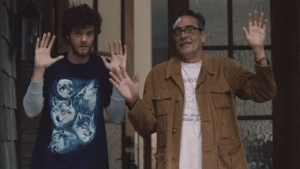
“Clown in a Cornfield finds” a good balance of slasher and comedy
After an eight-year hiatus, cult director Eli Craig returns to the horror-comedy genre with his latest film, “Clown in a Cornfield,” from RLJE Films.


2016 zombie action horror hit, Train to Busan receives a standalone sequel in Train to Busan Presents: Peninsula from Well Go USA. Yeon Sang-ho returns to the director’s chair for the sequel as does script scribe Joo-Suk Pak. Firstly, I want to point out that none of the original film characters make an appearance in the sequel, so if you are hoping to learn the fates of the characters Su-an and Seong-kyeong, prepare yourself for an upset.
Instead, Train to Busan Presents: Peninsula takes place four years after the zombie outbreak in Train to Busan. The Korean peninsula is devastated and follows Jung Seok (Dong-Won Gang). Train to Busan Presents: Peninsula opens with Jung Seok attempting to get his family to safety. Naturally, tragedy strikes, and one of Jung Seok’s family becomes infected.
Four years later, the guilt-ridden and former soldier is still on good terms with his brother in law Chul-min (Kim Do-yoon). Soon,Jung Seook is given a mission to go back to Incheon. Journeying to the quarantined peninsula and retrieve an abandoned food truck that contains bags of cash totaling US$20 million, he unexpectedly meets survivors.
Zombie flicks are either a hit or miss; however, Train to Busan changed the game with its premise. For argument’s sake, director Yeon Sang-ho could have easily set the sequel on another train in a different part of Korea. On the contrary, the director and his writer Joo-Suk Pak up the ante with death-defying stunts, great CGI zombie makeup, and excellent car chases.
While the film is subtitled, the plot is pretty easy to follow, and you’ll be engrossed in the action that the subtitles won’t throw you off. Suppose you’re expecting a rehash of the first. In that case, you’ll be sorely disappointed, and some viewers may find fault with the almost video game approach. Remember the two keys rules of a sequel as established by Randy Meeks in Scream 2. Number 1, the body count is always bigger, and Number 2 makes the death scenes much more elaborate. In that regard, Train to Busan Presents: Peninsula delivers the goods.
Horror movie purists are sure to find fault with the plot device of using humans as opposed to zombies as the primary villain. Movie buffs may have an issue with Jung Seok plot armor as well as the only real character giving an arc. I’m also quite sure that the remote control car scene (you’ll know it when you see it) is going to become a Meme soon.
More Mad Max than Day of the Dead, Train to Busan Presents: Peninsula is a simple fun ride. Violence, K-Pop songs, and impressive camera work, Train to Busan Presents: Peninsula is recommended for fans of the first film and foreign cinema fans.
Final Grade: B-


After an eight-year hiatus, cult director Eli Craig returns to the horror-comedy genre with his latest film, “Clown in a Cornfield,” from RLJE Films.

First-time director Felipe Vargas explores the consequences of forgetting one’s roots in the chilling horror film “Rosario,” produced by Highland Film Group and Muchio Mass Media. Alan Trezza wrote the screenplay, which begins with our titular character, a Mexican immigrant, receiving her first communion. After a spooky incident involving her eerie grandmother, it becomes evident that Rosario is destined to move on when she grows older.

Director Duncan Skiles taps into the buddy pic genre for his feature debut in “Neighborhood Watch” from RJLE Films. Simon (Jack Quaid) is a young man grappling with mental illness who becomes convinced that he has witnessed an abduction. When he reports it to the police, and they refuse to believe him, he reluctantly seeks the help of his neighbor Ed (Jeffrey Dean Morgan), a jaded, retired security guard with a troubled past. As the unlikely duo delves deeper into the mystery, their pursuit of the truth forces them to confront the disappearance’s dark secrets and the unspoken wounds that haunt them.
Reviews And Dunn is a unique blog showcasing all things cinema, music & theater.